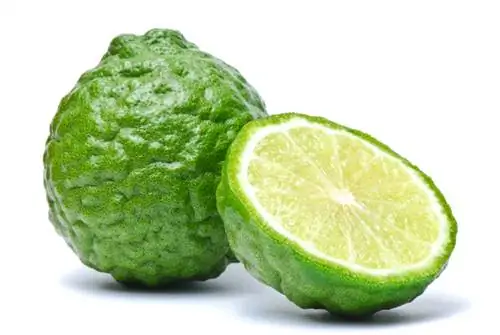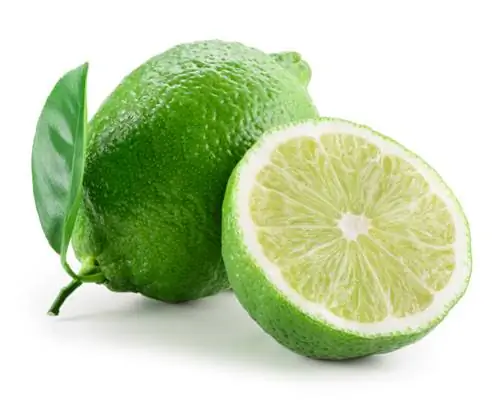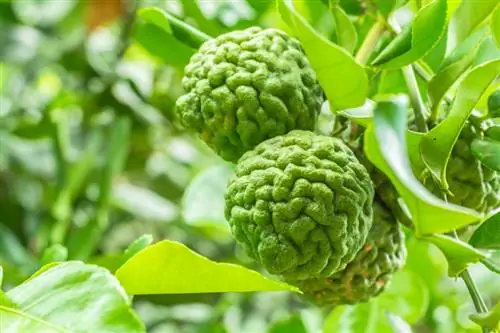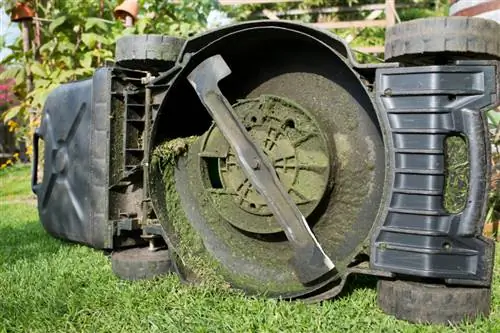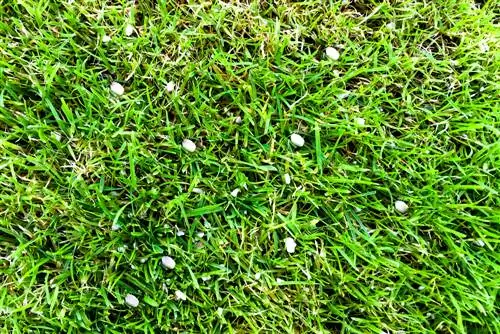- Author admin [email protected].
- Public 2023-12-16 16:46.
- Last modified 2025-01-23 11:20.
The Kaffir lime or Kaffir lime, Latin Citrus hystrix (i.e. prickly, due to the heavily thorny branches) is botanically one of the Papedas, a citrus family that is only slightly related to the better-known species. The plant is also called Mauritius papeda or makrut.

Are kaffir limes banned in Germany?
There is no import ban for kaffir limes (Citrus hystrix) in Germany. The plants are available online and grown in specialist nurseries. However, fresh leaves and fruits are rare in supermarkets and are usually only available as dried or frozen versions in Asian shops.
Where does the name Kaffir lime come from?
Why the exotic citrus species is called “Kaffir lime” in many European languages is still an unsolved mystery today. It's actually an insulting term; after all, "Kaffir" was a very derogatory term for people of color, especially in colonial times. The South African ethnic group the Xhosa in particular was called this during the apartheid era. The term “Kaffir” is now classified as hate speech and is therefore banned.
Does the Kaffir lime get its name from Arabic?
But the plant, which is very widespread in Southeast Asia, does not necessarily have to take its name from the “Kaffirs”. Instead, there is a second type of interpretation, according to which the word comes from the Arabic “kafir” for “infidel” or “village” (in the sense of “backward”). However, this derivation does not allow any conclusions to be drawn about the actual meaning of the name.
Import of Kaffir limes not prohibited
Apart from the very strange name - the origin of which will probably not be deciphered any time soon - rumors circulate from time to time on the web that the import of Kaffir limes and other Southeast Asian products/goods would be banned. Well, lovers of Thai cuisine don't need to worry, because the Kaffir lime is and remains quite readily available in the age of the Internet - even if such an import ban has neither been discussed nor implemented yet. Kaffir limes are now also grown in specialized nurseries, with the trees usually being grown from cuttings and grafted onto a suitable base. You can purchase such a plant in any online garden store.
Related types of Kaffir lime
Related species of the Kaffir lime include the Alemow (Citrus macrophylla) with its large, rusty-skinned fruits and the Melanesian papeda (Citrus macroptera). The former is often used as a grafting base, the latter is an impressive plant with huge, shiny leaves and orange-sized fruits.
Fresh leaves and fruits are not available in supermarkets
In contrast to the whole plant, fresh leaves and fruits are not available in German supermarkets. You can only purchase dried or frozen Kaffir lime leaves in specially stocked Asian stores - but only rarely there because these spices are not often in demand. The fruit peels or the fruits themselves are neither available fresh nor dried in Germany - there is simply no market for them. So if you would like to cook original Thai food, you basically have no choice but to purchase a small Kaffir lime tree - don't worry, it doesn't take much effort to care for.
Tips & Tricks
Instead of the leaves of the Kaffir lime or its fruit peel, you can also use the leaves and peel of the commercially available lime (Key lime or Mexican lime, Latin Citrus aurantiifolia). This is easier to get (in any supermarket). However, dishes prepared from it do not taste nearly as aromatic as the original.

